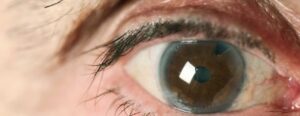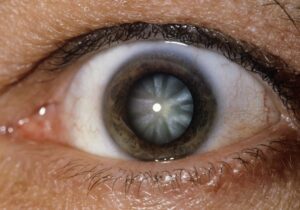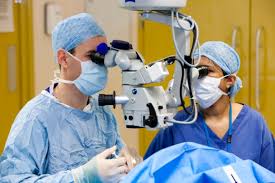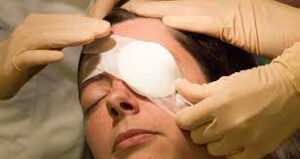A cataract is the leading cause of blindness in the world. In this comprehensive guide, we will discuss everything you need to know about cataracts. What are they? What are the symptoms? How are they treated? We will answer all of your questions!
What Is A Cataract?

A cataract is a clouding of the eye’s lens. The lens is a clear, curved piece of tissue that helps focus light into the eye. When the lens becomes cloudy, it prevents light from reaching the retina — the back part of the eye that senses light and sends images to the brain.
Cataracts usually form slowly and painlessly. They can occur in one or both eyes and usually affect people as they age. By age 80, more than half of all Americans have cataracts or have had surgery to remove them.
Types Of Cataracts

There are several types of cataracts, including:
- Clouding that occurs from birth or shortly thereafter (congenital). Some people develop cataracts very early in life which might be a result of faulty genes, intrauterine infections, or other causes. This usually does not require immediate treatment and its development can be slowed by using prevention methods.
- Clouding that develops in the innermost layer of the lens (nuclear). This type of cataract may not be noticeable at first but will eventually cause the center of your field of vision to become blurry.
- Cataracts that form in the back layer of the lens (posterior). These cataracts usually don’t impact your vision as much as other types, but can cause “glare” or light sensitivity. This type is less common.
- Cataracts that develop in the front part of the lens (cortical). These cataracts start as white opacities on the outer edge of the lens and work their way to the center. They can create a spoke-like pattern that casts shadows on your vision.
- Clouding that affects the front and center of the lens (subcapsular). This type is more likely to occur in people with diabetes or other disorders that affect metabolism or who take certain medications, such as steroids.
- Clouding that affects the edges of your lens (peripheral). This type is more common in people with diabetes.
These are only a few of the types of cataracts. Your doctor can help you determine what type of cataract you have and how it is impacting your vision.
How Is A Cataract Formed?
As we know, A cataract is a cloudy lens. But have you ever wondered how it becomes cloudy in the first place? The lens is made up of water and protein. The protein is arranged in a way that keeps the lens clear and allows light to pass through. But as we age, some of the protein may clump together and start to cloud a small area of the lens. Over time, the cataract may grow larger and cloud more of the lens, making it harder to see.
Cataracts are a natural part of aging. But they can also be caused by other factors, such as disease, trauma, or exposure to certain chemicals or radiation.
Symptoms Of Cataract

Most cataracts develop slowly and don’t disturb your vision at first. Early symptoms of cataract include:
- Squint eyes: You may squint or frown more when you’re trying to read, drive, or do other activities that require clear vision.
- Glare: Lights may seem too bright, and light from headlights, lamps, or the sun may cause discomfort. You also may see glare around bright objects.
- Fading colors: Colors may not appear as bright as they used to.
- Poor night vision: You may have more difficulty seeing at night.
- Double vision or multiple images in one eye (monocular diplopia): This happens when the cataract blocks some of the light entering your eye, making it difficult for your brain to process what you see.
- Blurry vision: As the cataract grows, it becomes more difficult to see.
Cataracts usually don’t cause pain. But if you have a sudden onset of symptoms or your vision changes quickly, contact your doctor right away. This could be a sign of another eye condition that needs treatment.
Causes Of Cataract

Cataracts are usually caused by aging and the natural breakdown of proteins in the lens of your eye. But cataracts can also be caused by other factors, such as:
- Myopia: If you’re nearsighted, you have difficulty seeing objects that are far away. This is because the light entering your eye focuses in front of your retina instead of on it. This can cause the lens to become damaged and cloudy.
- Hyperopia: If you’re farsighted, you have difficulty seeing objects that are close up. This is because the light entering your eye focuses behind your retina instead of on it. This can also cause the lens to become damaged and cloudy.
- Aging: As you age, the proteins in your lens begin to break down and clump together. This makes the lens cloudy and difficult to see through.
- Medical conditions: Cataracts can be caused by certain medical conditions, such as diabetes, hypertension, or glaucoma.
- Trauma: Cataracts can also be caused by trauma to the eye, such as a blow to the head or eye surgery.
- Exposure to certain chemicals: Exposure to certain chemicals, such as pesticides, herbicides, and industrial chemicals, can also cause cataracts.
- Radiation therapy: Radiation therapy to the head or eyes can also cause cataracts.
- Prolonged exposure to sunlight: Prolonged exposure to ultraviolet (UV) light can damage the proteins in your lens and lead to cataracts.
- Smoking and drinking: Smoking and drinking alcohol can also increase your risk of developing cataracts.
These are some the factors that can cause cataracts. It’s important to visit your doctor regularly for eye exams so they can check for cataracts and other eye conditions.
Diagnosis Of Cataract

Your doctor will perform a comprehensive eye exam to check for cataracts. This will include:
- Visual acuity test: This measures how well you see at different distances. It assesses sharpness and clarity of your vision.
- Slit-lamp examination: This is a special microscope that allows your doctor to examine your eye closely. They will examine your iris, cornea, lens, and retina for any abnormalities.
- Pupil dilation: Your doctor will dilate your pupils with eye drops so they can get a better view of your retina and lens.
- Tonometry: This measures the pressure inside your eye. High eye pressure can be a sign of glaucoma, which is a serious eye condition.
After the exam, your doctor will discuss your treatment options with you.
Treatment

On the basis of the severity of your symptoms, your doctor will decide whether you need treatment for your cataracts. If your vision is only slightly blurry and you’re not having any other symptoms, your doctor may just recommend that you wait and see if your vision gets worse.
If your cataracts are causing problems with your vision, your doctor will recommend surgery to remove them. Different surgical operations for cataract are:
- Phacoemulsification: This is the most common type of cataract surgery. It involves using ultrasound waves to break up the Cataract into small pieces. The pieces are then suctioned out of your eye.
- Extracapsular surgery: This type of surgery is used for larger Cataracts. It involves making a large incision in the front of your eye and removing the Cataract in one piece.
- Intracapsular surgery: This is the most invasive type of Cataract surgery. It involves making a large incision in the front of your eye and removing the Cataract in one piece.
Cataract surgery is a very common and safe procedure. It’s usually done on an outpatient basis, which means you can go home the same day.
Risk Of Surgery
As with any surgery, there are some risks involved with Cataract surgery. These include:
- Infection: This is a rare complication but can occur if bacteria enter your eye during surgery.
- Bleeding: This can occur if your blood pressure is too high or you have a bleeding disorder.
- Swelling: This can occur if you have allergies or if your body reacts to the surgery.
- Glaucoma: This is a rare complication but can occur if the pressure in your eye increases during or after surgery.
- Cystoid macular edema: This is a rare complication but can occur if fluid accumulates in your macula, the center of your retina.
- Retinal detachment: This is a rare complication but can occur if the retina becomes detached from the back of your eye.
Cataract surgery is a very safe and effective procedure. However, as with any surgery, there are some risks involved. These risks are rare but it’s important to be aware of them.
Aftercare

After your surgery, you will need to take some precautions to avoid complications. These include:
- Wearing glasses: This will protect your eyes from the sun and wind.
- Avoid strenuous activity: This will help your eye heal properly.
- Wearing a protective shield: This will protect your eye from injury.
- Using artificial tears: This will help keep your eye moist and prevent infection.
Your doctor will also likely prescribe some eye drops for you to use. These will help protect your eye and prevent infection.
Methods Of Prevention
There are some things you can do to reduce your risk of developing Cataracts. These include:
- Children should wear sunglasses that block out UV rays when they are outdoors.
- People with hypertension should have their blood pressure monitored by a doctor.
- Children should wear protective eyewear when participating in activities that could lead to an eye injury.
- This should be done every one to two years, or as recommended by your doctor.
- People with diabetes should have their blood sugar levels checked regularly and managed by a doctor.
- Pregnant women should be vaccinated against Rubella, chickenpox, and toxoplasmosis to decrease the risk of congenital infection.
- People with myopia should have their eyes checked regularly by an eye doctor.
Cataracts are a common condition that can occur at any age. However, there are some things you can do to reduce your risk of developing Cataracts.
Conclusion
Lastly, Cataract is a common condition that can occur at any age. Early detection is important to prevent the progression of the disease. There are many treatment options available, and surgery is usually successful in restoring vision.
We hope you found this article helpful. If you want to get started with your eye evaluation, we suggest you book an appointment with one of these hospitals.
If you have more questions, do consult the experts at Eye Mantra. We have a team of experienced eye surgeons, who will be happy to answer your any questions on cataract surgery, cataract surgery cost, cataract lens cost for different cataract surgery types- Phacoemulsification, MICS & Femto Laser Cataract. Call us at +91-9711116605 or email at [email protected] for inquiries.


